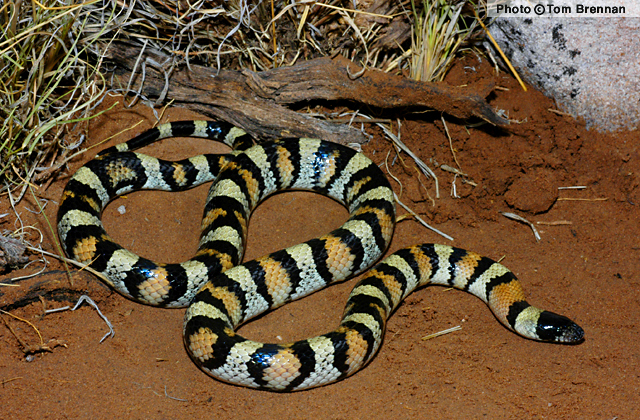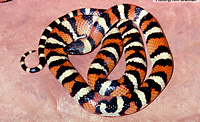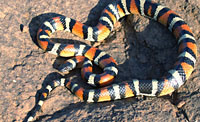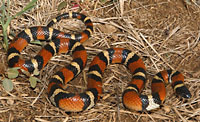Online Field Guide to The Reptiles and Amphibians of Arizona



Navajo County, AZ
 Coconino Co., AZ |
||
 Cochise Co., AZ |
| MILKSNAKE Lampropeltis triangulum |
Non-Venomous
|
| DESCRIPTION: A medium-sized (up to 900 mm or 35.5″ in total length) snake with red, black, and white bands. The white bands are bordered by the black bands. The black bands usually get wider at the midline of the back (mid-dorsally) encroaching into the red bands. In some individuals the black bands widen so much mid-dorsally that they “bridge” across the red and touch one-another. The snout is black and is occasionally marked with light speckles or flecks. The venter is usually white with the black and red dorsal bands encroaching in from the sides and terminating before reaching the midline. Ventral coloration on 10 Cochise County Arizona specimens ranged from solid black on one specimen, roughly equal distribution of red black and white on 8, and one specimen with a nearly plain white venter. The pupils are round and the scales are smooth and shiny. The Milksnake’s black snout distinguishes it from the similar looking Sonoran Mountain Kingsnake which has a light snout.
DISTRIBUTION: This snake is distributed across a large portion of the state’s northeastern plateau region and a small portion of southeastern Arizona. Its secretive nature makes it difficult to document distribution. In Arizona it is likely much more broadly distributed than we currently know. In our state it has been found at elevations ranging from 4,200′ to ca. 6,200′. HABITAT: The Milksnake is found on open plains, low valleys, and rolling hills within Plains and Great Basin Grassland and Semidesert Grassland communities. DIET: Milksnakes feed on reptiles, mice, other small mammals, small birds, amphibians, and invertebrates. REPRODUCTION: Mating takes place in spring and a clutch of up to 24 eggs is laid in summer. Hatchlings appear in late summer. A Cochise County, Arizona female I collected in July laid 6 eggs shortly after capture (in mid July). Four of the six eggs hatched on 14 September. REMARKS: Protected in Cochise County. It is against Arizona State law to harass, harm, pursue, hunt, shoot, wound, kill, trap, capture, or collect this animal in Cochise County AZ, or to attempt to engage in any such conduct. Bartlett. 2000. Snakes of North America: Western Region. Gulf Publishing Co. Houston, TX Brennan, T. C., and A. T. Holycross. 2006. A Field Guide to Amphibians and Reptiles in Arizona. Arizona Game and Fish Department. Phoenix, AZ Degenhardt, W. G., Painter, C. W., and Price, A. H.. 1996. Amphibians and Reptiles of New Mexico. University of New Mexico Press. Albuquerque. Fowlie. 1965. The Snakes of Arizona. Azul Quinta Press, Fallbrook, California Stebbins. 1985. Western Reptiles and Amphibians. Houghton Mifflin. New York, NY |
|
Visit Partners in Amphibian and Reptile Conservation:


HOME
Copyright © 2023, Arizona Game and Fish Department. All rights reserved.
If you make use of the textual contents of this site in reports, publications, etc. please cite and credit the author(s) and photographer(s). All photos on this website are copyrighted. However, those found in the species account section may be used for any noncommercial scientific, educational, or conservation purposes provided that photographs are not altered and continue to bear the copyright symbol and name of the photographer. Please contact the photographer regarding commercial use of copyrighted photographs.












